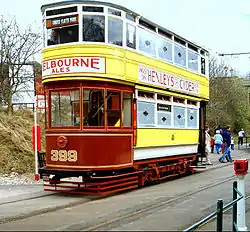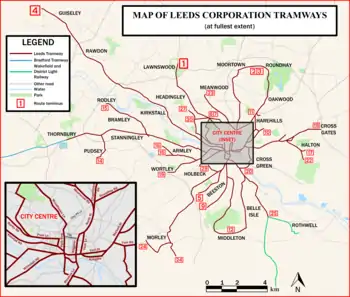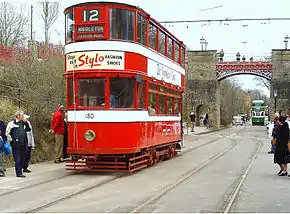Leeds Corporation Tramways
Leeds Corporation Tramways formerly served the city of Leeds, England. The original trams were horse-drawn, but the city introduced Britain's first overhead-powered electric trams in 1891,[1] and by 1901, electrification had been completed. The tramway opened on 29 October 1891.[2]
 A 1925 Leeds tram at the National Tramway Museum in Crich, Derbyshire | |
| Overview | |
|---|---|
| Headquarters | Leeds |
| Locale | England |
| Dates of operation | 29 October 1891–7 November 1959 |
| Successor | Abandoned |
| Technical | |
| Track gauge | 4 ft 8 1⁄2 in (1,435 mm) |
| Electrification | overhead catenary |
Routes



There were several lines running between the city centre[3] and Cross Gates,[4] Chapel Allerton,[5][6] Moortown,[7] Roundhay,[8] Middleton,[9] Beeston,[10] Armley,[11] Hunslet[12] and Kirkstall.[13] The network, of which certain sections were on reserved track, was far more extensive than that of the proposed Leeds Supertram, which has not been built after a funding shortfall from central government.
Trams
The earliest trams were single decker horsedrawn trams, but later purchases were double deckers, operated by Leeds Tramways Company. The last of these ran in 1901. Steam trams were also used until full electrification. Throughout most of the twentieth century the tramway used a mixture of bus style and balloon trams, both in double-decker formation.[14] The system of collection by trams from the overhead wiring was unusual in that it used bow collectors rather than poles, obviating the need to turn the pole round at each terminus.
Even when other cities were abandoning their tramways in the 1940s, Leeds continued to modernise its system. Two prototype modern single-deck trams (somewhat similar to those used in continental European cities) were built in the early 1950s, in particular two single deck trams painted purple for the coronation, was in operation on route 3 to Roundhay in 1953 – perhaps because this followed a segregated track along Roundhay Road to the popular attraction of Roundhay Park. These two were a conventional air and magnetic braked vehicle (601) and an all electric "vambac" car (602). The latter resides in the Crich tramway museum.
In the early 1950s (1951), Leeds purchased 90 "Feltham" secondhand trams (dating from 1931), from London Transport. By this period, Leeds tramcars were normally painted in red.
Closure
After the closure of the Leeds system on 7 November 1959,[2] Sheffield became the last city in England operating trams (closing in 1960), with Glasgow (Scotland) the last in the UK (closing in 1962). The Blackpool tramway then became the UK's only commercial tramway, until the opening of the Manchester Metrolink in 1992.
It is argued that the closure of the tramway was shortsighted, particularly given the fact that the majority of the network ran on reserved track, and as such did not interfere with the road system. Leeds had one of largest and most advanced urban transport systems in the UK, and was developing new tramcars and opening new lines right until its closure. The people of Leeds have now tried multiple times since the 1980s to get their tramway back, with no success.
Preservation
Several Leeds electric trams are now preserved at the National Tramway Museum at Crich. The last remaining Leeds horse tram, number 107, has been restored by the Leeds Transport Historical Society and is currently on display at the National Tramway Museum.[15] What were once commonly thought to have been original tram poles remaining in Roundhay were actually lighting standards in a bus park. There is an old electricity sub station used for the tramway on Abbey Road in Hawksworth.[16]
Queens Hall
Queens Hall was the central tram shed, situated off Swinegate. This was used as a concert hall from the trams closure until 1989, when it was demolished. Queens Hall became a renowned punk venue and hosted other artists such as Elton John. However, the venue's poor acoustics and high upkeep costs brought about its closure. The site is an unmade car park; the proposed Criterion Place development was to be built here.
References
- http://www.crecy.co.uk/early-electric-trams-of-britain
- "LRTA – Electric Tramways of Yorkshire". Retrieved 16 September 2009.
- a photographic archive of Leeds – Display. Leodis (12 July 1952). Retrieved 19 October 2011.
- a photographic archive of Leeds – Display. Leodis (9 January 1956). Retrieved 19 October 2011.
- a photographic archive of Leeds – Display. Leodis. Retrieved 19 October 2011.
- a photographic archive of Leeds – Display. Leodis (16 December 1954). Retrieved 19 October 2011.
- a photographic archive of Leeds – Display. Leodis (2 April 1936). Retrieved 19 October 2011.
- a photographic archive of Leeds – Display. Leodis. Retrieved 19 October 2011.
- a photographic archive of Leeds – Display. Leodis (22 February 1937). Retrieved 19 October 2011.
- a photographic archive of Leeds – Display. Leodis (15 March 1910). Retrieved 19 October 2011.
- a photographic archive of Leeds – Display. Leodis (6 February 1929). Retrieved 19 October 2011.
- a photographic archive of Leeds – Display. Leodis (28 November 1958). Retrieved 19 October 2011.
- a photographic archive of Leeds – Display. Leodis (11 April 1928). Retrieved 19 October 2011.
- http://johnlawontherails.fotopic.net/p24610499.html%5B%5D
- Leeds Horse car 107 restoration project. Leedshorsecar107.squarespace.com (16 September 2009). Retrieved 19 October 2011.
- a photographic archive of Leeds – Display. Leodis (20 May 2007). Retrieved 19 October 2011.
External links
- Photos of Leeds trams from 1953
- Leeds City Tramways at the British Tramway Company Badges and Buttons website
